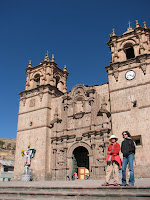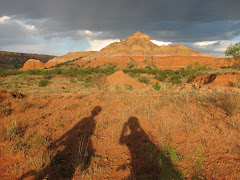
We venture out after breakfast and check out the Museum de Carlos Dreyer. Dreyer was a german antiques collector who lived in Puno for many years. When he died he bequeathed his collection to the city of Puno, and they put together the museum. Interesting artifacts from the Pre-Inca through Spanish Colonization.

We step just outside and around the corner to the Plaza de Armas, and sit on the cathedral steps to watch a parade. It is a happy, festive event, but for a cause. The parade consists mostly of students, all carrying signs that proclaim in one way or another that kids should be in school, not working a job. Interesting. We step into a cafe in a little art coop, where I have Coca tea for the trillionth time. I will be addicted to Coca by the time we leave.
Back at the hotel we verify that there will in fact be no train running tomorrow. Crap. Yolanda finds us the 1 bus that will be making a special trip, taking the long way around. We get some of the last seats. We walk around and check with a few

travel agents, and verify that this is indeed the ONLY bus, or transport of ANY kind that will be going from Puno to Cusco tomorrow. Normally it is a 6 hour bus or train ride, but due to the circuitous route required, this will be a 12 HOUR RIDE! Oh well, we feel fortunate to have gotten it. Yolanda only speaks spanish, and very rapidly, even though Allison has asked numerous times for her to please slow down. Allison & my mom have done the most Spanish studying by far, and I (and especially Terry) lean on them throughout the trip, although most of the time I can squeak by alone. Yolanda's supercharged spanish is incredibly frustrating to Allison, but to her credit, she'd hooked us up with an excellent Titicaca tour, the fantastic experience at Balconies de Puno (NOT in Lonely Planet), and the ONLY transportation from Puno to Cusco.
Many of our activities, restaurants, and hotels have come from the Lonely Planet guide, as has our next destination for today, The Yavari Project. The Yavari is the oldest single-propeller driven iron ship in working order today. It was ordered by the Peruvian government in 1861 from the James Watt Foundry in Birmingham, England. Its purpose would be to collect goods from around Lake Titicaca. There was no rail to Puno at the time, so the ship had to be built in a modular fashion, with no single part being heavier than a mule could carry.

It was then carried over the Andes to Lake Titicaca, at 12,500 feet above sea level, and reassembled. It was launched on Christmas Day of 1870. It was originally powered by

a steam engine meant to burn coal, but coal was lacking, so it ran on dried llama dung. In the early 1900s the engine was replaced with a semi-diesel. In 1975 the boat was passed on to the Peruvian Navy, which let it slide into a sad state of disrepair. In 1987 some british enthusiasts evaluated its restoration potential, found it to be worthy, and started a non-profit with this goal in mind. Now it is nearly 100% restored, and open for tours. This was really cool to see. We also knocked out another of our goals with this little side trip as well, which was to take a Moto-Taxi. A Moto-Taxi is basically a three-wheeled vehicle constructed largely of one motorcycle front-end paired with two motorcycle rear-ends, and a small vinyl cabin for passengers. They are everywhere here.

We head to dinner at Ukuku, and have some really good pizza. Also we have the best beer we've tried yet - Franco. We've been through three or four brands so far, and all of them have that salty-club-soda-mixed-with-
Side note - There are dogs everywhere in Peruvian cities, roaming free. We ask if they are strays, and are told that no, they belong to someone, and in fact they all look well-fed, just dirty. They are always headed somewhere with purpose, as if on a mission. I guess they just do as they please around the cities in the daytime, and head home at night. (The dog in the photo above is the dog that Allison decided she should bring home with us. Of course, it was not interested in us at all, just kept moving its nap spot to stay in the sun.)

No comments:
Post a Comment